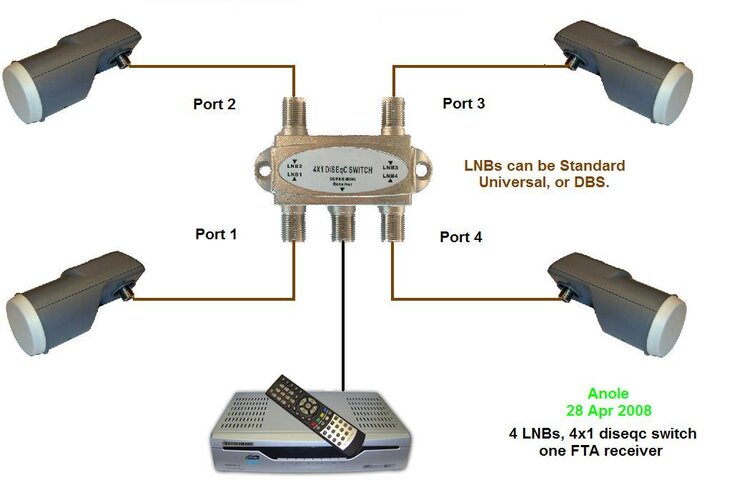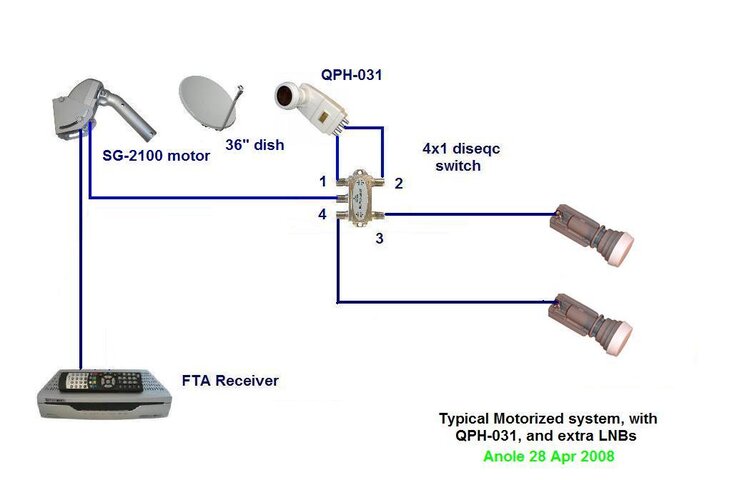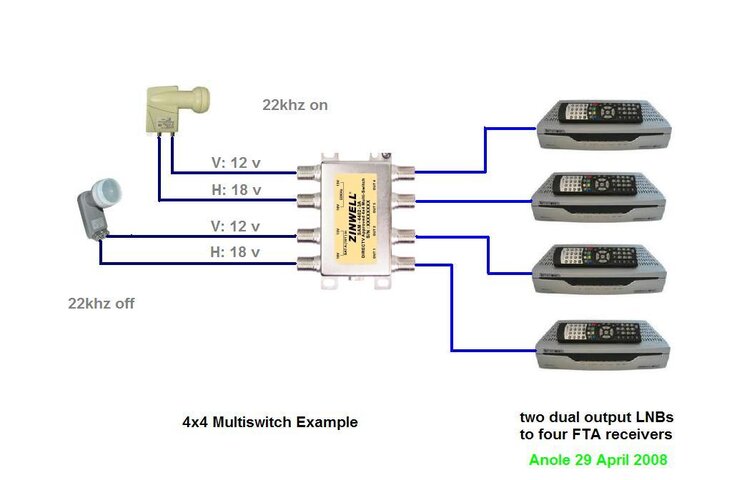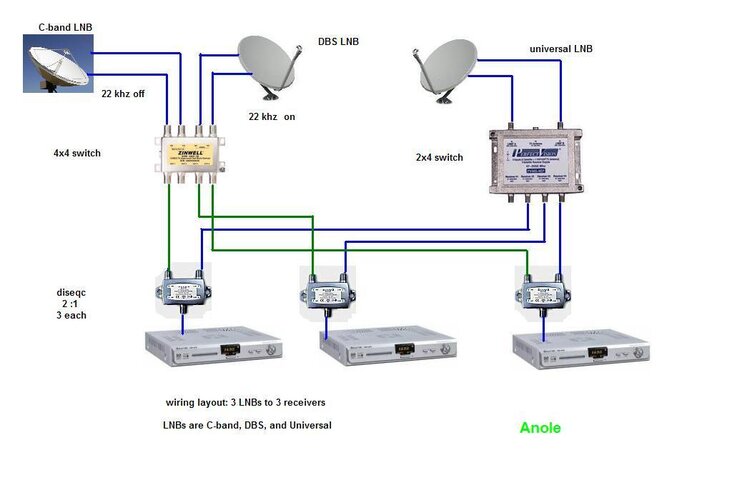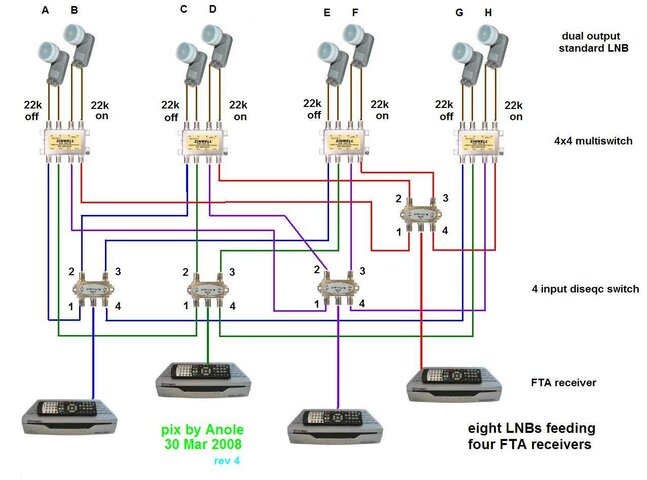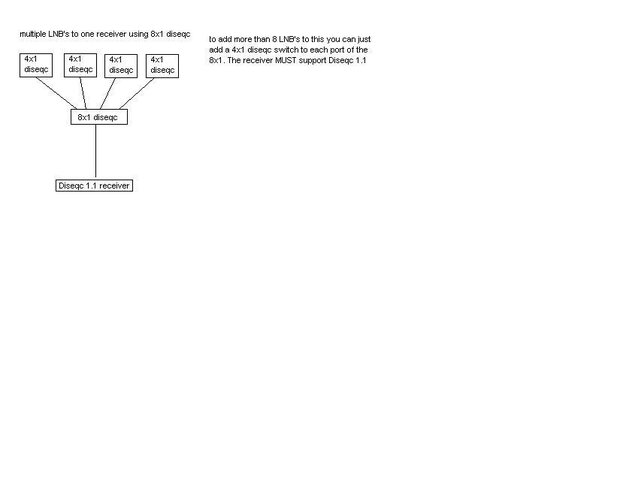Introduction:
Lots of basic switch questions come up every month.
I'm no expert on the subject, but I've been paying close attention to the people who've been putting them to work.
Some have come up with very complicated switching matrices from the simple building blocks.
So, for a while, I've thought we should roll the basics into one document which might answer many of the more common questions.
This weekend, I ran the idea past Iceberg for his input.
We'll try to keep to 22khz (two kinds), diseqc (two kinds), and multiswitches (two kinds, again).
He suggested we don't get into use of bandstacked LNBs, but they could be the basis of another thread, if needed.
Ku band LNBs:
Before talking about switches, it's necessary to understand the more common kinds of LNBs.
Why? Because some have built in switching, and that interacts with our external switches.
Standard FTA LNBs deal with one band of satellite frequencies, and have one Local Oscillator frequency (LO).
So, no additional switching is built into the LNB.
These regular FSS, or linear, or FTA LNBs have an LO of 10750mhz.
The DBS (direct broadcast satellite) LNBs for pay TV, have an LO of 11250mhz, and work similarly.
However, the term Standard, is used only for the FTA or FSS band, not pay TV.
So, while for most of the following switch ideas, these LNBs can be interchanged, you have to use the right LNB for the job.
Universal FTA LNBs deal with two bands of satellite frequencies, and have two Local Oscillator frequencies (LO).
To select the higher band (the one we use in North America), you must supply a 22khz tone to the LNB. LO=10600
If you don't, the LNB reverts to the lower of the two LO frequencies and low band (which is useful for Europe and Eastern satellites). LO=9750
As we shall see later, the internal 22khz switch of the Universal LNBs sometimes limit their use.
Singles and Duals
LNBs are further divided into single output and dual output models.
The Singles have one connector, and give the receiver Vertical transponders when fed 12 volts, and Horizontal transponders when fed 18 volts.
The Dual LNBs have two connections which operate as above.
For more complicated switching, you can put one output to 12 volts for Vertical and 18 volts for Horizontal, and get both polarities at the same time.
That feature will be exploited in some of the following designs.
See other documents (or our FAQ) if the above is not sufficient, or is confusing.
Lots of basic switch questions come up every month.
I'm no expert on the subject, but I've been paying close attention to the people who've been putting them to work.
Some have come up with very complicated switching matrices from the simple building blocks.
So, for a while, I've thought we should roll the basics into one document which might answer many of the more common questions.
This weekend, I ran the idea past Iceberg for his input.
We'll try to keep to 22khz (two kinds), diseqc (two kinds), and multiswitches (two kinds, again).
He suggested we don't get into use of bandstacked LNBs, but they could be the basis of another thread, if needed.
Ku band LNBs:
Before talking about switches, it's necessary to understand the more common kinds of LNBs.
Why? Because some have built in switching, and that interacts with our external switches.
Standard FTA LNBs deal with one band of satellite frequencies, and have one Local Oscillator frequency (LO).
So, no additional switching is built into the LNB.
These regular FSS, or linear, or FTA LNBs have an LO of 10750mhz.
The DBS (direct broadcast satellite) LNBs for pay TV, have an LO of 11250mhz, and work similarly.
However, the term Standard, is used only for the FTA or FSS band, not pay TV.
So, while for most of the following switch ideas, these LNBs can be interchanged, you have to use the right LNB for the job.
Universal FTA LNBs deal with two bands of satellite frequencies, and have two Local Oscillator frequencies (LO).
To select the higher band (the one we use in North America), you must supply a 22khz tone to the LNB. LO=10600
If you don't, the LNB reverts to the lower of the two LO frequencies and low band (which is useful for Europe and Eastern satellites). LO=9750
As we shall see later, the internal 22khz switch of the Universal LNBs sometimes limit their use.
Singles and Duals
LNBs are further divided into single output and dual output models.
The Singles have one connector, and give the receiver Vertical transponders when fed 12 volts, and Horizontal transponders when fed 18 volts.
The Dual LNBs have two connections which operate as above.
For more complicated switching, you can put one output to 12 volts for Vertical and 18 volts for Horizontal, and get both polarities at the same time.
That feature will be exploited in some of the following designs.
See other documents (or our FAQ) if the above is not sufficient, or is confusing.



